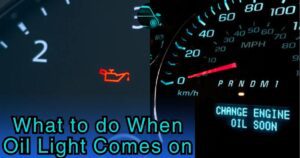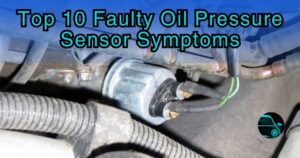Ever wondered why the oil light comes on but oil is full in your car? It’s a perplexing situation that can leave many drivers scratching their heads in confusion. This mystery is more common than you might think, and understanding the underlying reasons is crucial for maintaining your vehicle’s health. When the oil light illuminates despite having a full oil reservoir, it signals a discrepancy between what your car is communicating and its actual condition.
This article aims to demystify this puzzling scenario, exploring the potential causes and solutions when the oil light comes on but oil is full. From sensor issues to oil quality, we’ll dive into the key factors that could be misleading your dashboard’s warning lights. Stay tuned to unravel this automotive enigma and ensure your car’s oil system is functioning as it should.
Understanding the Oil Light
Navigating the intricacies of car maintenance can sometimes feel like solving a puzzle, especially when faced with perplexing signals like an oil light warning despite having a full oil reservoir. This scenario often leads drivers to wonder about the reliability of their vehicle’s alerts. It’s essential to grasp that the oil light is not solely a measure of oil quantity but a broader indicator of your engine’s lubrication system’s health. When the oil light comes on but oil is full, it signals potential issues that demand immediate attention.
Firstly, this warning could indicate a malfunctioning oil pressure sensor, sending inaccurate alerts to the driver. Secondly, it might reveal problems with the oil pump, which, despite sufficient oil, fails to maintain the proper oil pressure essential for engine lubrication. Thirdly, the oil light coming on but oil is full could point towards a clogged oil filter, restricting oil flow and thus triggering the warning light. Each of these situations underscores the importance of not just monitoring oil levels but also ensuring the entire lubrication system operates efficiently.
Understanding the broader implications when the oil light comes on but oil is full is crucial for maintaining engine health and preventing costly repairs. It’s a call to investigate and address potential issues within the lubrication system, ensuring your vehicle continues to run smoothly and reliably.
The Conundrum: Oil Light Comes On But Oil Is Full
Now, onto the heart of the matter. There are several reasons why your car might display this confounding signal, even when the oil tank is adequately filled:
1. Faulty Oil Pressure Sensor
One of the most common culprits is a malfunctioning oil pressure sensor. This sensor monitors the oil pressure in your engine and sends this information to the dashboard. If it fails or becomes faulty, it can incorrectly trigger the oil light, despite there being sufficient oil in the engine.
2. Oil Quality Issues
The quality of the oil in your engine plays a pivotal role in its performance. Over time, oil can degrade, losing its viscosity and effectiveness as a lubricant. Moreover, using the incorrect type of oil for your vehicle can also lead to inadequate lubrication. Both scenarios can result in low oil pressure, thus illuminating the oil light.
3. Oil Pump Failure
The oil pump is responsible for circulating oil under pressure to the engine’s moving parts. If the pump is failing or is inefficient due to wear and tear, it can’t maintain the required oil pressure, leading to the activation of the oil light.
4. Clogged Oil Filter
A clogged oil filter can restrict the flow of oil, causing a drop in oil pressure. Regular maintenance and timely replacement of the oil filter are crucial to preventing this issue.
5. Engine Wear
Over time, an engine’s internal components can wear down, leading to increased clearances that may result in oil pressure drops. This wear and tear can be exacerbated by irregular maintenance and the use of low-quality oils.
6. Sludge Build-Up
Sludge formation inside your engine can obstruct the normal flow of oil, causing low oil pressure. This sludge buildup is typically a result of infrequent oil changes or using oil that doesn’t meet the vehicle manufacturer’s specifications.
Diagnosing and Fixing the Issue
When that pesky oil light illuminates your dashboard, it’s natural to feel a twinge of concern, especially when you’ve already checked and confirmed that your oil levels are where they should be. This contradiction might leave you scratching your head, wondering about the next steps to ensure your vehicle stays in tip-top shape. Here, we delve into how to diagnose and address this issue, ensuring your car runs smoothly without any false alarms.
Diagnosing the root cause when the oil light comes on but oil is full involves a systematic approach:
1. Check the Oil Pressure Sensor: This sensor monitors oil pressure and, if faulty, can trigger the light. A professional mechanic can test the sensor’s functionality and replace it if necessary. This is a common solution when the oil light comes on but oil is full, as the sensor might send incorrect signals to the car’s computer.
2. Inspect the Oil Pump: The oil pump is responsible for circulating oil under pressure to the engine’s moving parts. A failing pump can lead to low oil pressure, illuminating the oil light even when oil levels are adequate. A comprehensive evaluation by a mechanic can determine if the pump needs replacement.
3. Evaluate the Oil Filter: Sometimes, a clogged oil filter can cause a drop in oil pressure, which in turn, triggers the oil light. Replacing the oil filter is an easy and cost-effective step that might resolve the issue.
4. Professional Diagnostic Test: For a more thorough diagnosis, a professional diagnostic test can uncover any electrical faults or deeper engine issues that could cause the oil light to come on but oil is full. This might involve checking the engine control unit (ECU) for any error codes that indicate specific problems.
5. Regular Maintenance and Monitoring: After addressing any immediate concerns, regular maintenance is crucial. Ensure you’re using the right type and grade of oil for your vehicle, as recommended by the manufacturer. Also, keep an eye on the oil light and any changes in your car’s performance.
By following these steps, you can effectively diagnose and fix the issue when the oil light comes on but oil is full, safeguarding your vehicle’s engine and ensuring peace of mind on the road. Remember, while it might be tempting to ignore the light if you know the oil isn’t low, doing so could risk serious engine damage. It’s always best to tackle the problem head-on, ensuring your car remains reliable for years to come.
Prevention: The Best Cure
When it comes to keeping your car in top condition, preventing issues before they arise is key, especially concerning the oil system. The frustrating scenario where the oil light comes on but oil is full can often be avoided with regular maintenance and vigilance. Here are several steps to prevent this issue from cropping up:
1. Regular Oil Changes: Ensure you follow the manufacturer’s recommended schedule for oil changes. Fresh oil not only lubricates but also helps to ensure that the oil pressure is maintained at optimal levels, reducing the likelihood of the oil light warning.
2. Use Quality Oil: Opt for high-quality oil that matches your vehicle’s specifications. Good quality oil can prevent sludge buildup by ensuring the oil flows freely and maintains the correct pressure, which is crucial in preventing situations where the oil light comes on but oil is full.
3. Check Oil Levels Frequently: Even if your car isn’t due for an oil change, periodically check your oil levels. This habit can help catch leaks or consumption issues early before they trigger the oil light.
4. Regularly Replace the Oil Filter: A clogged oil filter can cause oil pressure to drop, which might result in the oil light warning. Replacing the oil filter as part of your regular maintenance schedule helps maintain proper oil flow and pressure.
5. Inspect for Leaks Regularly: Keep an eye out for any signs of oil leaks under your car. A leak might not immediately cause low oil levels that you can detect by checking the dipstick, but it can lead to reduced oil pressure, causing the oil light to come on even when the oil is full.
By adhering to these preventative measures, you can significantly reduce the chances of facing the puzzling situation where the oil light comes on but oil is full. Regular maintenance not only keeps the oil light off but also extends the life of your engine, ensuring smooth and reliable performance.
Conclusion
In conclusion, navigating the confusion when the oil light comes on but oil is full can be a perplexing experience for any driver. However, understanding that this signal can be indicative of various issues, not just low oil levels, is crucial. From potential sensor malfunctions to more serious engine concerns, it’s important to address this warning light promptly to safeguard your vehicle’s health. Remember, regular maintenance and a keen eye on your car’s performance are your best defenses against unexpected troubles. The next time you find yourself puzzled by why the oil light comes on but oil is full, take it as a sign to investigate further and ensure your vehicle continues to run smoothly and efficiently.
FAQ
1. Why does the oil light come on when my oil level is full?
The oil light illuminates not just to indicate low oil levels but also to alert you to potential issues with oil pressure or the engine’s lubrication system. If the oil light comes on but oil is full, it could be a sign of a faulty oil pressure sensor, a problem with the oil pump, or a clogged oil filter.
2. Can I keep driving if the oil light comes on but the oil is full?
It’s advisable to stop driving and check the situation as soon as safely possible. Driving with the oil light on, even if the oil level is full, could indicate serious issues that might risk engine damage.
3. How do I check if the oil pressure sensor is the problem?
If the oil light comes on but oil is full, one potential culprit could be the oil pressure sensor. Diagnosing this usually requires a professional mechanic who can test the sensor’s functionality and ensure the oil pressure is within the manufacturer’s specified range.
4. What should I do immediately when the oil light illuminates but I’ve confirmed the oil is full?
First, safely pull over and turn off the engine. Check for any obvious signs of oil leaks under the car. If everything seems normal, it’s best to consult with a professional mechanic to diagnose the issue properly.
5. How often should I check my oil level to avoid seeing the oil light come on?
Regular maintenance is key. Check your oil level at least once a month and before any long trip to ensure it’s at the proper level. However, remember that the oil light is not solely an indicator of oil level but potentially a warning sign of other lubrication system issues.




